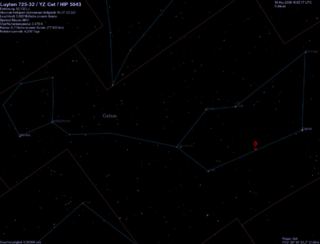YZ Ceti
|
Star YZ Ceti |
|||||||||||
|---|---|---|---|---|---|---|---|---|---|---|---|

|
|||||||||||
| Position of YZ Ceti in the constellation Whale | |||||||||||
| AladinLite | |||||||||||
|
Observation dates equinox : J2000.0 , epoch : J2000.0 |
|||||||||||
| Constellation | whale | ||||||||||
| Right ascension | 01 h 12 m 30.64 s | ||||||||||
| declination | -16 ° 59 ′ 56.4 ″ | ||||||||||
| Apparent brightness | 12.07 (12.03 to 12.18) mag | ||||||||||
| Typing | |||||||||||
| Known exoplanets | 3 | ||||||||||
| B − V color index | +1.81 | ||||||||||
| U − B color index | +1.43 | ||||||||||
| R − I index | +1.76 | ||||||||||
| Spectral class | M4.0 Ve | ||||||||||
| Variable star type | BY + UV | ||||||||||
| Astrometry | |||||||||||
| Radial velocity | (+28.1 ± 0.1) km / s | ||||||||||
| parallax | (269.36 ± 0.08) mas | ||||||||||
| distance | (12.10 ± 0.01) ly (3.71 ± 0.01) pc |
||||||||||
| Visual absolute brightness M vis | approx. 14 mag | ||||||||||
| Proper movement | |||||||||||
| Rec. Share: | (+1205.18 ± 0.17) mas / a | ||||||||||
| Dec. portion: | (+637.76 ± 0.12) mas / a | ||||||||||
| Physical Properties | |||||||||||
| Dimensions | (0.135 ± 0.003) M ☉ | ||||||||||
| radius | (0.169 ± 0.005) R ☉ | ||||||||||
| Effective temperature | (3056 ± 60) K. | ||||||||||
| Metallicity [Fe / H] | (−0.26 ± 0.08) | ||||||||||
| Age | (4.0 ± 0.6) bill. A | ||||||||||
|
Other names and catalog entries |
|||||||||||
|
|||||||||||
YZ Ceti is a red dwarf in the constellation Cetus (whale). Although it is relatively close to the Sun at a distance of around 12 light years , the star can not be observed with the naked eye due to its low apparent magnitude of only around 12 mag . He has a planetary system that consists of at least three, but possibly four, exoplanets .
The name part "YZ" follows the rules for naming variable stars and says that YZ Ceti is the 53rd variable star discovered in the constellation Whale.
properties
YZ Ceti is a UV Ceti star (flare star ) that shows periodic changes in its luminosity . Its mass is only about 8.5% of the mass of the sun, the star is 5500 times fainter than it.
Planetary system
In August 2017, a team of astronomers led by Nicola Astudillo-Defru announced the discovery of three planets around YZ Ceti after measurements with the Échelle spectrograph HARPS of the European Southern Observatory (ESO). At the time of their discovery, they were the lowest-mass exoplanets found using the radial velocity method .
The three planets are named YZ Ceti b , YZ Ceti c and YZ Ceti d and are many times closer to their central star than Mercury is to the sun. Their orbital times are only between about 2 and 4.6 earth days. Their minimum masses are comparable to the mass of the earth . YZ Ceti b has 0.75 times, YZ Ceti c 0.98 times, and YZ Ceti d 1.14 times the minimum mass of the earth. YZ Ceti b and YZ Ceti c continue to orbit approximately in a 2: 3 resonance around YZ Ceti. A planet with a minimum mass of 0.472 earth masses and an orbital period of 1.04 earth days is considered possible, but could not be confirmed with certainty.
|
Planet (by distance from the star) |
Discovery (year) |
Mass (in M ⊕ ) |
Cycle time (in days) |
Major semi-axis (in AU ) |
eccentricity |
|---|---|---|---|---|---|
| YZ Ceti b | 2017 | 0.75 ± 0.13 | 1.96876 ± 0.00021 | 0.01557 ± 0.00052 | 0.0 ± 0.12 |
| YZ Ceti c | 2017 | 0.98 ± 0.14 | 3.06008 ± 0.00022 | 0.02090 ± 0.00070 | 0.04 ± 0.11 |
| YZ Ceti d | 2017 | 1.14 ± 0.17 | 4.65627 ± 0.00042 | 0.02764 ± 0.00093 | 0.129 ± 0.096 |
Closest neighbors
YZ Ceti is unusually close to Tau Ceti , a yellow dwarf star belonging to the spectral class G8. Both stars are only about 1.6 light years apart. This is only a little more than a third of the distance between the Sun and its closest neighbor, Proxima Centauri . As with YZ Ceti, a planetary system has also been detected around Tau Ceti.
See also
Individual evidence
- ↑ a b c d e f g h i YZ Cet. In: SIMBAD . Center de Données astronomiques de Strasbourg , accessed September 16, 2018 .
- ↑ a b YZ Cet. In: VSX. AAVSO, accessed September 16, 2018 .
- ↑ a b c d e f g N. Astudillo-Defru et al .: The HARPS search for southern extra-solar planets XLII. A system of Earth-mass planets around the nearby M dwarf YZ Cet . arxiv : 1708.03336 .
- ↑ Nearest stars until 10pc (Zakhozhaj, 1979–1996)
- ↑ a b P. E. Kervella, F. Arenou, F. Mignard, F. Thévenin: Stellar and substellar companions of nearby stars from Gaia DR2. Binarity from proper motion anomaly . In: Astronomy & Astrophysics . 623, p. A72. arxiv : 1811.08902 . bibcode : 2019A & A ... 623A..72K . doi : 10.1051 / 0004-6361 / 201834371 .
- ↑ a b c YZ Cet c. In: Extrasolar Planets Encyclopaedia . Retrieved September 16, 2018 .